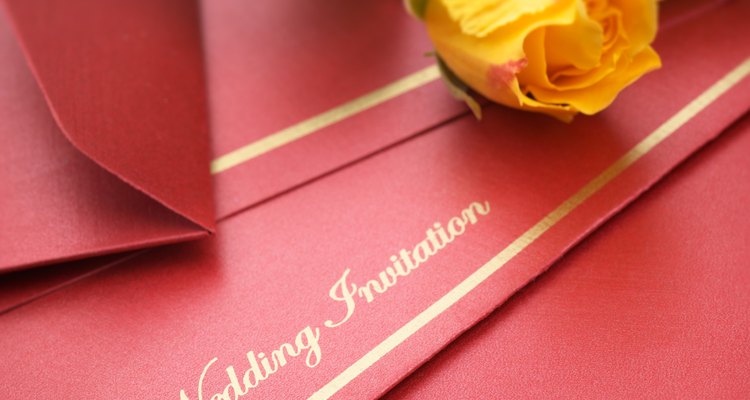
Douglas Freer/iStock/Getty Images
Traditional etiquette holds that whoever hosts the wedding issues the invitations. A deceased father cannot act as a host, making his inclusion on the host line improper. However, contemporary practice does allow for variations in format to recognize a deceased parent, provided the wording does not imply that the invitation comes from him.
Father of the Bride Recognition
An invitation that reads "Mr. and Mrs. John Doe request…" implies that both parents are alive. To recognize the bride's deceased father, word your invitation as follows: "The pleasure of your company is requested at the marriage of Jane Mary Doe daughter of Mary Doe and the late John Doe to John William Smith." Use "The honor of your presence…" for a ceremony held in a house of worship.
Recognizing the Groom's Father
To recognize the groom's deceased father, wording for the bride's parents should mirror that used for the groom's. For example, place "Jane Mary Doe" on the first line followed by "daughter of Mrs. and Mrs. John Doe" on the second. Then, after the word "and" on its own line, note the groom's information: "John William Smith, son of Mrs. William Smith and the late Mr. Smith request the…"
Hispanic Tradition
In Latin America, a deceased father is listed on the second line of a wedding invitation, followed by a religious symbol: either a cross or Star of David. Non-Hispanic guests may not recognize the significance of this format.
Related Articles

How to Write a Wedding Invitation

How to Address an Envelope With ...

How to Address Bridal Shower Invitations

Etiquette for Wedding Invitations When ...

How Do You Address Wedding Invitations ...

Correct Way to Write an Acceptance for ...

How to Address an Invitation to a Pastor

How to Get a Marriage License in Guam

Wedding Etiquette for a No Gifts ...

How to Write a Newspaper Engagement ...

How to Word Recital Invitations

What Is a Nice Way to Request a Prompt ...

How to Word an Invitation for a Female ...

How to Legally Change a Child's Last ...

Bar Mitzvah Invitation Etiquette

Etiquette to Respond to an RSVP

Wedding Etiquette for Name Order

Etiquette on Putting a Wedding ...

Thank You Note Etiquette for Envelopes

How to Construct a Seamstress ...
References
Writer Bio
Trudy Brunot began writing in 1992. Her work has appeared in "Quarterly," "Pennsylvania Health & You," "Constructor" and the "Tribune-Review" newspaper. Her domestic and international experience includes human resources, advertising, marketing, product and retail management positions. She holds a master's degree in international business administration from the University of South Carolina.
Photo Credits
Douglas Freer/iStock/Getty Images